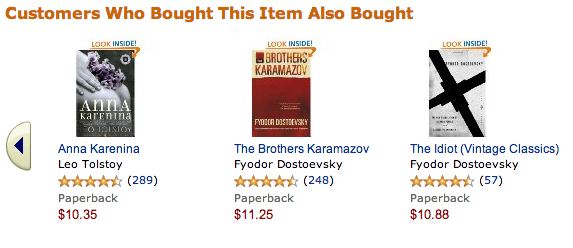The methods we have looked at so far work well when you have numeric ratings of how much a user liked a product. This type of information is not always available, as it requires active behavior on the part of consumers.
Basket analysis is an alternative mode of learning recommendations. In this mode, our data consists only of which items were bought together; it does not contain any information on whether or not individual items were enjoyed. Even if users sometimes buy items they regret, on average, knowing their purchases gives you enough information to build good recommendations. It is often easier to get this data rather than rating data, as many users will not provide ratings, while the basket data is generated as a side effect of shopping. The following screenshot shows you a snippet of Amazon.com's web page for Tolstoy's classic book War and Peace, demonstrating a common way to use these results:

This mode of learning is, of course, not only applicable to shopping baskets. It is applicable in any setting where you have groups of objects together and need to recommend another one. For example, recommending additional recipients to a user writing an email is done by Gmail, and could be implemented using similar techniques (we do not know which methods Gmail uses internally; perhaps they combine multiple techniques, as we did earlier). Or, we could use these methods to develop an app to recommend web pages to visit based on your browsing history. Even if we are handling purchases, it may make sense to group all purchases made by a customer into a single basket, independently of whether the items were bought together or in separate transactions. This depends on the business context, but keep in mind that the techniques are flexible and can be useful in many settings.
One of the stories that is often mentioned in the context of basket analysis is the diapers and beer story. When supermarkets first started to look at their data, they found that diapers were often bought together with beer. Supposedly, it was the father who would go out to the supermarket to buy diapers and would then pick up some beer as well. There has been much discussion of whether this is true or just an urban myth. In this case, it seems that it is true. In the early 1990s, Osco Drug discovered that, in the early evening, beer and diapers were bought together, and it did surprise the managers who had, until then, never considered these two products to be similar. What is not true is that this led the store to move the beer display closer to the diaper section. Also, we have no idea whether it was really true that fathers were buying beer and diapers together more than mothers (or grandparents).
